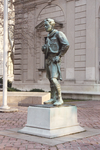Board of Education Building (Philadelphia)
Government buildings completed in 1930Government buildings on the National Register of Historic Places in PhiladelphiaLogan Square, PhiladelphiaModerne architecture in PennsylvaniaNeoclassical architecture in Pennsylvania

The Board of Education Building, also known as the Board of Education Administration Building, is a historic building in the Logan Square neighborhood of Philadelphia. As the long-time headquarters of what is now the School District of Philadelphia, it was a center of the city's educational system. It was completed in 1932. In recent years, it has been converted to residential use. The Board of Education Building was added in 1983 to the National Register of Historic Places.
Excerpt from the Wikipedia article Board of Education Building (Philadelphia) (License: CC BY-SA 3.0, Authors, Images).Board of Education Building (Philadelphia)
North 22nd Street, Philadelphia Center City
Geographical coordinates (GPS) Address Nearby Places Show on map
Geographical coordinates (GPS)
| Latitude | Longitude |
|---|---|
| N 39.958888888889 ° | E -75.175555555556 ° |
Address
North 22nd Street 298
19103 Philadelphia, Center City
Pennsylvania, United States
Open on Google Maps







